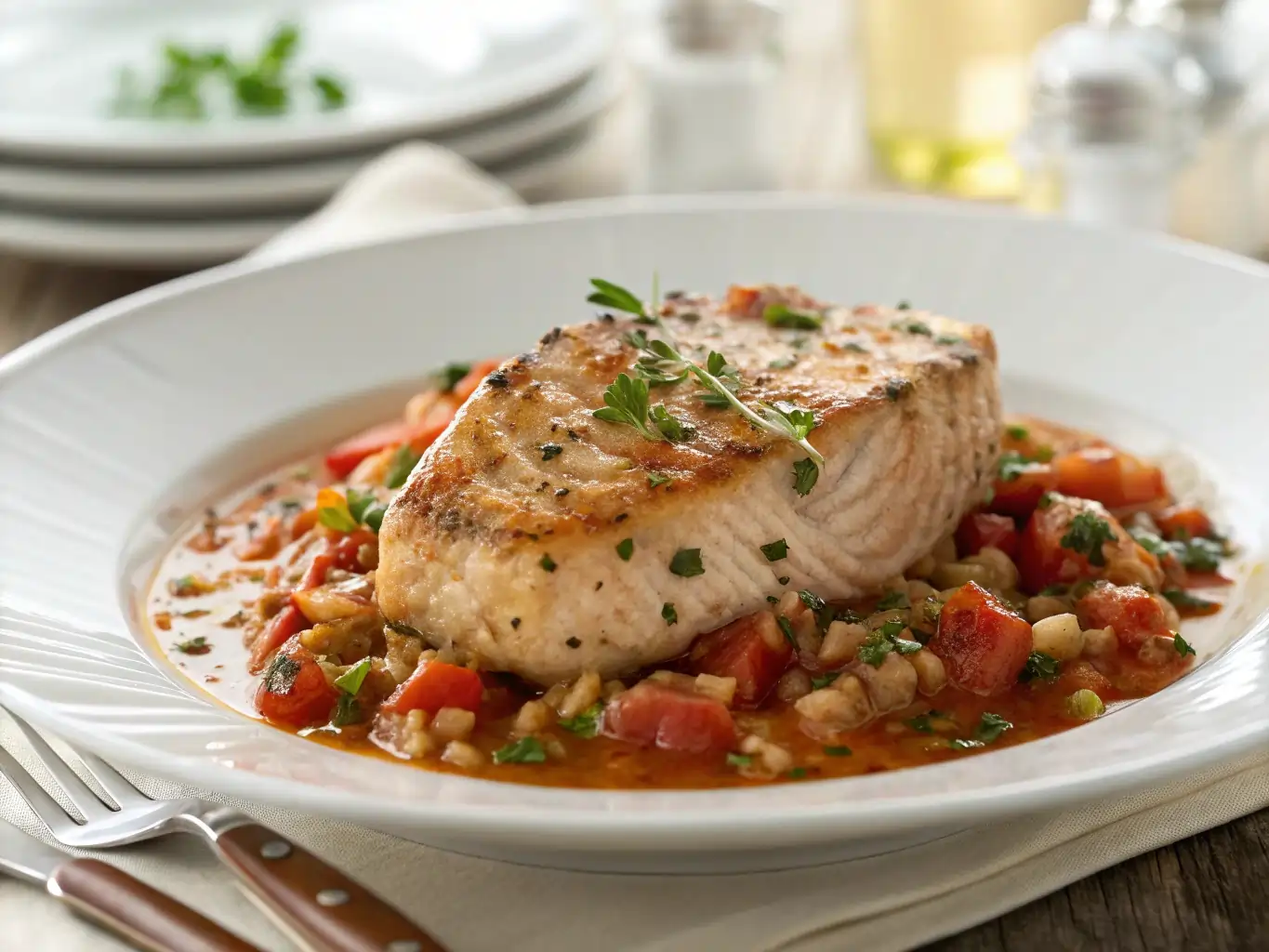Swordfish Recipe(Xiphias gladius) stands as one of the ocean’s most distinctive and prized culinary treasures. Named for its characteristic elongated, sword-like bill, this magnificent predator glides through warm and temperate ocean waters worldwide, growing up to 15 feet in length and weighing as much as 1,400 pounds in exceptional cases. Despite its imposing presence in the wild, swordfish arrives at your local seafood counter in manageable, meaty steaks that offer endless possibilities for healthy cooking.
What sets swordfish apart from other seafood options is its unique texture and flavor profile. Unlike delicate white fish that flakes easily, swordfish presents with a firm, almost steak-like consistency that holds up remarkably well to various cooking methods. This sturdy texture makes swordfish an excellent entry point for those typically hesitant about preparing seafood at home. The flesh is dense yet moist when properly cooked, with a mild, slightly sweet flavor that pairs beautifully with bold seasonings without being overwhelmingly “fishy.”
Nutritionally, swordfish deserves its reputation as a healthy protein source. Each serving delivers a substantial amount of lean protein (approximately 20 grams per 3-ounce portion), while also providing selenium, vitamin D, and those coveted omega-3 fatty acids that support heart and brain health. The meat’s distinctive pale pink to white color indicates its moderate fat content—enough to keep it juicy during cooking but still qualifying it as a relatively lean option for health-conscious diners.
Swordfish’s versatility in the kitchen is unmatched among seafood varieties. Whether you’re planning to grill, bake, broil, or pan-sear your swordfish steaks, this adaptable ingredient maintains its structural integrity while absorbing the flavors of marinades and seasonings. This quality makes it particularly well-suited for Mediterranean-style preparations featuring olive oil, fresh herbs, and citrus—a cooking approach we’ll explore in depth throughout this guide.
Table of Contents
What Makes Swordfish the Perfect Choice for Healthy Cooking
Swordfish has earned its place as a premium option on restaurant menus worldwide, but it deserves equal recognition in your home kitchen as a superb choice for health-conscious cooking. This remarkable fish offers a unique combination of nutritional benefits, culinary versatility, and satisfying texture that sets it apart from other seafood options when creating wholesome, delicious meals.
First and foremost, swordfish boasts an impressive nutritional profile that aligns perfectly with health-focused dietary goals. A single 3-ounce serving delivers approximately 20 grams of high-quality protein with relatively few calories (about 130-140 per serving), making it an excellent option for those managing their weight while ensuring adequate protein intake. Unlike fattier fish varieties, swordfish contains moderate levels of healthy fats—enough to provide flavor and moisture, but not so much as to significantly increase the caloric content.
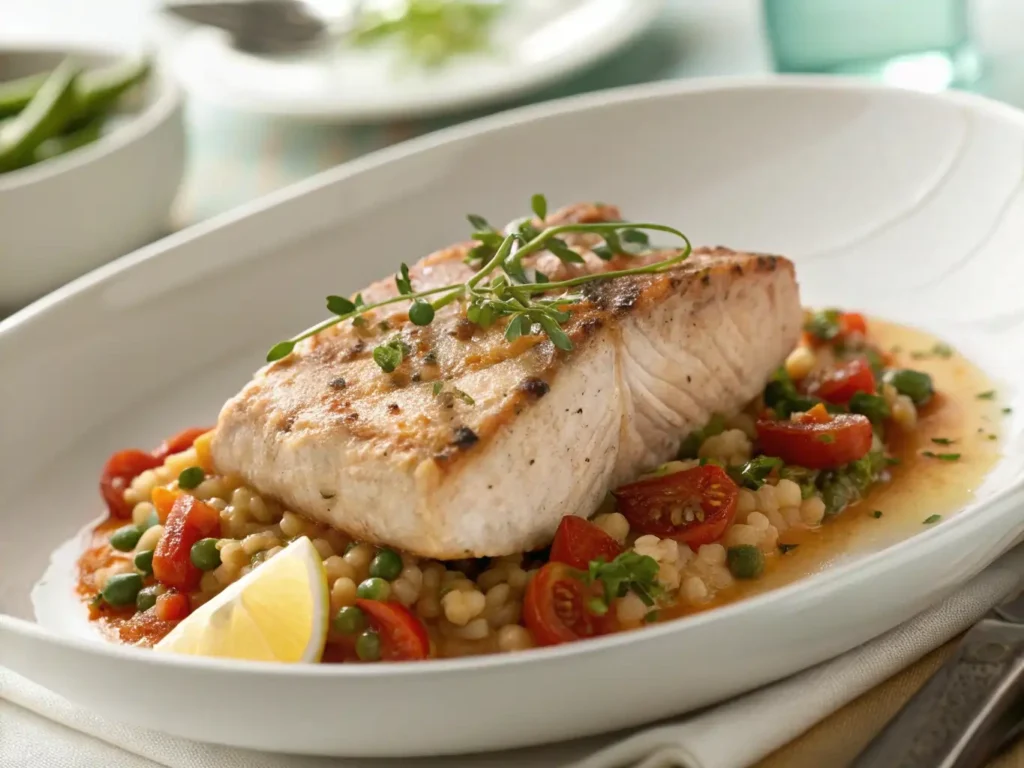
The protein structure of swordfish creates one of its most appealing culinary characteristics: a firm, meaty texture that stands up beautifully to various cooking methods. This structural integrity means you can grill, broil, bake, or pan-sear swordfish without it falling apart, a common challenge with more delicate fish varieties. For home cooks seeking healthy options that satisfy hearty appetites, swordfish delivers a substantive eating experience more reminiscent of a lean steak than typical seafood, making it particularly appealing to those transitioning toward more heart-healthy protein sources.
From a flavor perspective, swordfish offers a mild, slightly sweet taste with none of the strong “fishiness” that deters some diners from seafood. This approachable flavor profile creates a perfect canvas for healthy seasonings like fresh herbs, citrus, and olive oil—cornerstones of Mediterranean cuisine that complement swordfish perfectly while adding minimal calories and maximum nutritional benefit. The fish readily absorbs marinades, allowing you to infuse it with antioxidant-rich ingredients that enhance both health properties and taste.
Nutritionally speaking, swordfish delivers several key micronutrients important for overall wellness. It’s an excellent source of selenium (nearly 100% of your daily requirement in one serving), a mineral that supports thyroid function and helps protect cells from damage. It also provides substantial vitamin D, often lacking in modern diets yet crucial for immune function and bone health. The omega-3 fatty acids present in swordfish, while not as abundant as in oilier fish like salmon, still contribute to heart health and anti-inflammatory benefits.
Perhaps most importantly for busy health-conscious cooks, swordfish is remarkably forgiving and quick to prepare. Its even cooking properties mean less stress about precise timing, while its thickness allows it to remain juicy even with the high-heat cooking methods that create appealing caramelization and flavor development. In today’s time-pressed world, finding nutritious options that deliver reliable results with minimal fuss represents a genuine culinary win—a description that fits swordfish perfectly.
Preparing Your Swordfish Recipe for Cooking Success
Proper preparation is the foundation of any successful swordfish dish. The steps you take before heat ever touches your swordfish steaks can mean the difference between a restaurant-quality meal and a disappointing dinner. Let’s explore the essential preparation techniques that will set you up for swordfish success.
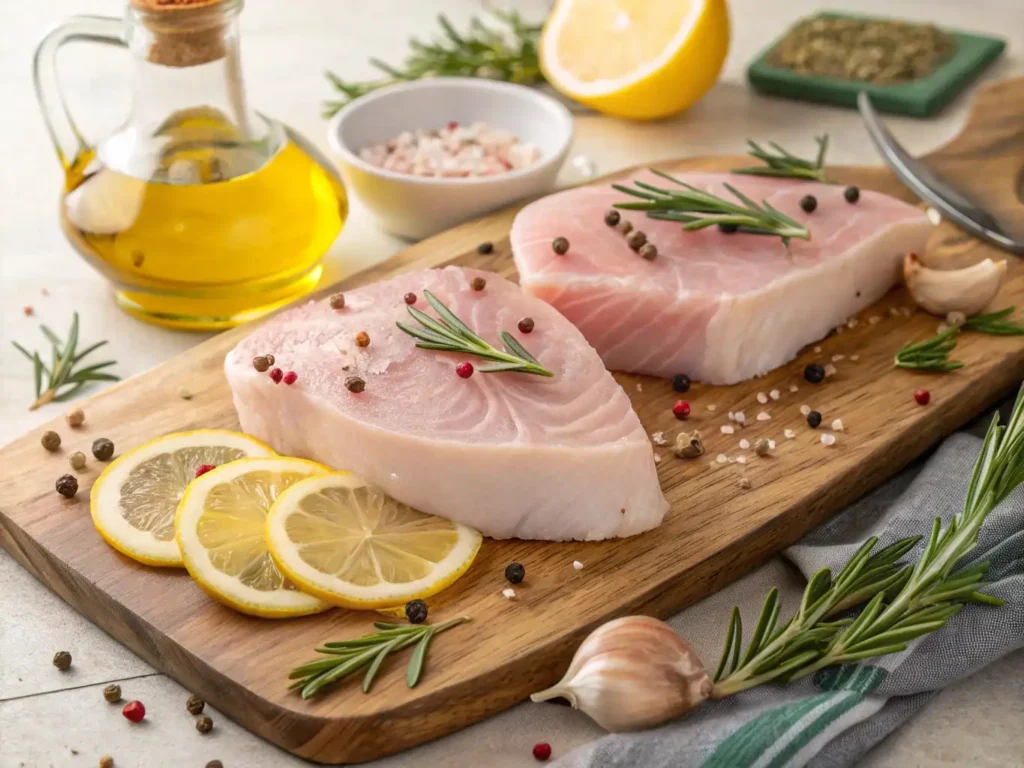
The journey begins at purchase—selecting quality swordfish is crucial. Look for steaks with firm, moist flesh that springs back when touched. The meat should display a pinkish-beige to white color, never brown or yellowing. Fresh swordfish has minimal “fishiness” in aroma; instead, it should smell clean and oceanic. For sustainability purposes, North Atlantic and Hawaiian swordfish are generally considered better environmental choices, so check with your fishmonger about sourcing.
Once home, proper handling continues. If not cooking immediately, store your swordfish in the coldest part of the refrigerator, preferably on ice, and use within 1-2 days of purchase. Before preparation, remove the steaks from refrigeration about 15-20 minutes before cooking—allowing them to approach room temperature promotes more even cooking, particularly important with swordfish’s thickness.
Most swordfish steaks come pre-trimmed, but examine yours for any dark areas along the edges, which represent blood line meat that can taste stronger. Using a sharp knife, carefully trim away these darker portions while maintaining the steak’s integrity. Some steaks might also have a tough skin section that’s best removed before cooking to prevent curling and ensure even heat distribution.
Pat the steaks dry thoroughly with paper towels before applying any seasoning or marinade. This critical step promotes proper searing and caramelization, especially important for grilling or pan-searing methods. Excess moisture is the enemy of the beautiful crust that characterizes perfectly cooked swordfish.
When it comes to seasoning, swordfish’s mild flavor provides an ideal canvas for creativity while requiring minimal intervention for delicious results. At its simplest, a generous application of quality sea salt and freshly ground black pepper allows the fish’s natural flavors to shine. For more complex flavor profiles, Mediterranean-inspired combinations work beautifully—think lemon zest, garlic, fresh herbs like oregano, thyme, or rosemary, and a drizzle of extra virgin olive oil.
Marinating swordfish requires special consideration. Unlike more delicate fish, swordfish’s robust structure can withstand longer marination—20 to 30 minutes is ideal, though up to an hour works for milder marinades. Avoid overly acidic marinades (like those heavy in lemon juice or vinegar) for extended periods, as they can “cook” the fish through acid denaturation, resulting in a less appealing texture. A balanced marinade might include olive oil, a modest amount of acid (lemon juice or white wine), aromatics (garlic, shallots), and herbs.
If you’re planning to grill your swordfish, consider soaking wooden skewers and threading them horizontally through thinner steaks to prevent curling during cooking. For any cooking method, bringing the fish to the proper thickness improves results—ideal swordfish steaks should be between 1 to 1½ inches thick. Thinner cuts cook too quickly and risk drying out, while thicker cuts may cook unevenly.
Some chefs employ a quick brine (a solution of salt water, sometimes with added sugar) for 15-20 minutes before cooking to enhance moisture retention. This optional step can be particularly helpful if you’re concerned about overcooking or working with slightly less-than-perfect swordfish.
Lastly, prepare your cooking environment properly. For stovetop cooking, ensure your pan (preferably cast iron or stainless steel) is thoroughly preheated. For grilling, clean and oil the grates properly to prevent sticking. Having the right tools at hand—a fish spatula, instant-read thermometer, and prepared serving platter—streamlines the cooking process and helps ensure your carefully prepared swordfish makes it to the table in perfect condition.
Foolproof Methods to Cook Perfect Swordfish Steaks
Swordfish’s unique texture stands as both its greatest culinary asset and its most significant cooking challenge. The firm, meaty consistency that makes it so satisfying can quickly become dry and tough when overcooked. Mastering the techniques for cooking swordfish perfectly requires understanding its distinctive properties and applying the right methods at the right temperatures. Let’s explore foolproof approaches that deliver moist, flavorful results every time.
The cardinal rule of cooking swordfish—regardless of method—is to avoid overcooking. Unlike fattier fish varieties that remain moist even when cooked through, swordfish requires vigilance. The ideal internal temperature ranges between 130°F to 135°F (54°C to 57°C), which produces a just-cooked center that remains moist and tender. An instant-read thermometer becomes your most valuable tool for consistently perfect results.
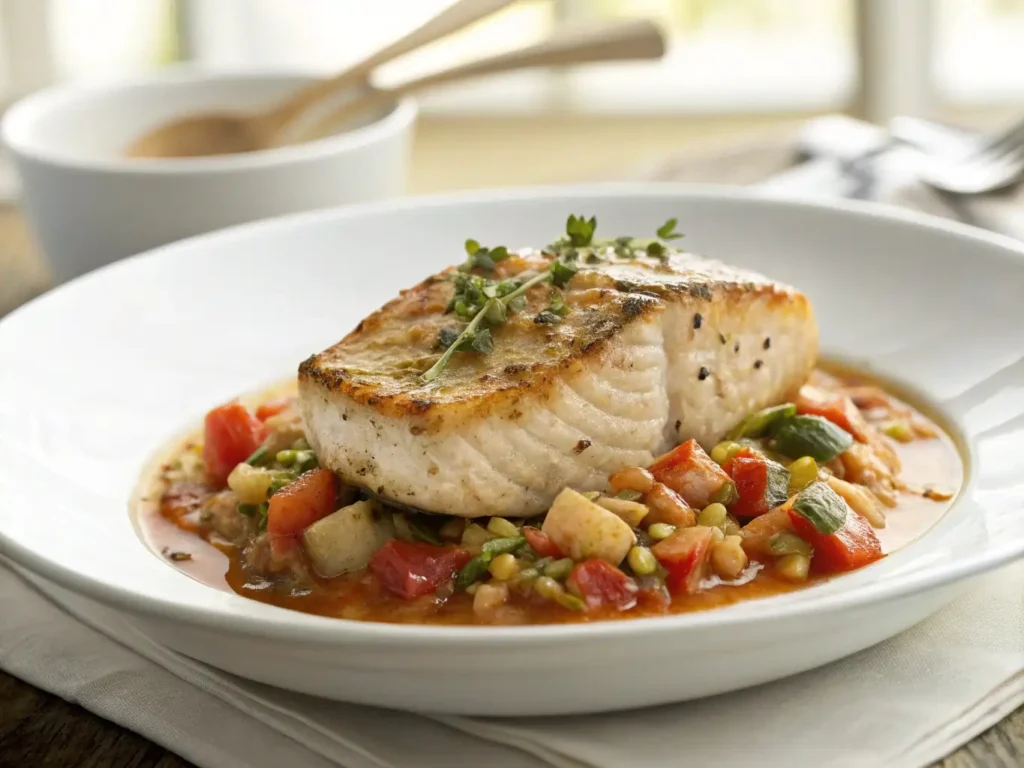
Pan-Searing: Creating the Perfect Crust
Pan-searing delivers exceptional results with swordfish, creating a flavorful caramelized exterior while maintaining a juicy interior. Begin with a heavy-bottomed skillet—preferably cast iron or stainless steel—preheated over medium-high heat. A properly heated pan is crucial; test by sprinkling a few drops of water, which should immediately dance and evaporate.
Add 1-2 tablespoons of high-smoke-point oil like grapeseed, avocado, or clarified butter. Once shimmering, carefully place your seasoned swordfish steaks in the pan, pressing gently to ensure full contact. The initial sizzle should be pronounced but not violent—adjust heat if needed. For 1-inch thick steaks, cook undisturbed for approximately 3-4 minutes until a golden-brown crust forms.
The key technique here is patience—resist the urge to move the fish prematurely. When properly seared, the fish will naturally release from the pan. Flip once using a fish spatula, then cook for an additional 2-3 minutes. In the final minute, consider adding a tablespoon of butter, some crushed garlic cloves, and fresh herbs to the pan, using a spoon to baste the fish with these aromatic flavors.
Grilling: Mastering Temperature Control
Grilling imparts distinctive smoky flavors that complement swordfish beautifully, but it requires careful attention to prevent sticking and overcooking. Start with a thoroughly cleaned grill, preheated to medium-high (around 400°F to 450°F/204°C to 232°C). Oil both the grill grates and the fish to create double protection against sticking.
Position swordfish steaks at a 45-degree angle to the grates for attractive crosshatch marks. Cook for approximately 4 minutes with the lid closed, then rotate 90 degrees (without flipping) and continue for another 2 minutes. This creates professional-looking diamond grill marks. Flip once and repeat the process on the second side, adjusting timing as needed.
For gas grills, consider creating a two-zone fire with one side at medium-high heat and the other at medium. This allows you to move thicker steaks to the cooler zone to finish cooking gently if the exterior is browning too quickly. For charcoal grills, arrange coals to create similar heat zones.
Baked Swordfish: The Gentle Approach
Baking offers a more forgiving method, particularly beneficial for novice cooks or when preparing multiple steaks simultaneously. Preheat your oven to 400°F (204°C) and place seasoned swordfish steaks on a lightly oiled baking sheet or in a shallow baking dish. For enhanced flavor and moisture retention, consider topping each steak with a compound butter (mixed with herbs, garlic, and lemon zest) or a light drizzle of olive oil and lemon juice.
Bake 1-inch thick steaks for approximately 10-12 minutes, checking internal temperature at the 8-minute mark. The gentler heat of baking provides a wider window of perfect doneness, though you’ll sacrifice the caramelized crust achieved through higher-heat methods. To compensate, some chefs finish baked swordfish with a quick broil for the final 1-2 minutes to add surface browning.
Broiling: High-Heat Efficiency
Broiling combines the ease of oven cooking with the intense heat that creates appealing caramelization. Position your oven rack 4-6 inches from the heating element and preheat the broiler for at least 5 minutes. Place seasoned swordfish on a broiler pan or heavy-duty baking sheet lined with foil.
Broil 1-inch steaks for approximately 4 minutes, then flip and continue for another 2-3 minutes. The intense top heat creates beautiful browning while cooking quickly enough to prevent moisture loss. Because broilers vary significantly in intensity, visual cues become important—look for browning at the edges and slight opacity in the center as indicators to check temperature.
The Secret to Perfect Doneness
Regardless of cooking method, understanding doneness indicators ensures success. Beyond temperature, visual cues help determine when swordfish is perfectly cooked. The flesh transforms from translucent to opaque as it cooks, with perfectly done swordfish displaying just the faintest hint of translucence at the center. When gently pressed with a finger, the fish should feel firm but with slight give—similar to pressing the base of your thumb when touching your index finger to your thumb.
For optimal juiciness, incorporate a 3-5 minute rest period after cooking. Tent loosely with foil (not tightly, which would cause steaming and soften your carefully created crust) and allow carryover cooking to complete the process while redistributing juices throughout the fish. This resting period often represents the difference between good and exceptional swordfish.
Serving Your Perfect Swordfish Steaks
Creating a memorable swordfish dinner extends beyond mastering cooking techniques—the presentation, accompaniments, and complementary flavors transform perfectly cooked swordfish into a complete dining experience. The final touches you apply after cooking are just as crucial as the preparation and cooking methods themselves.
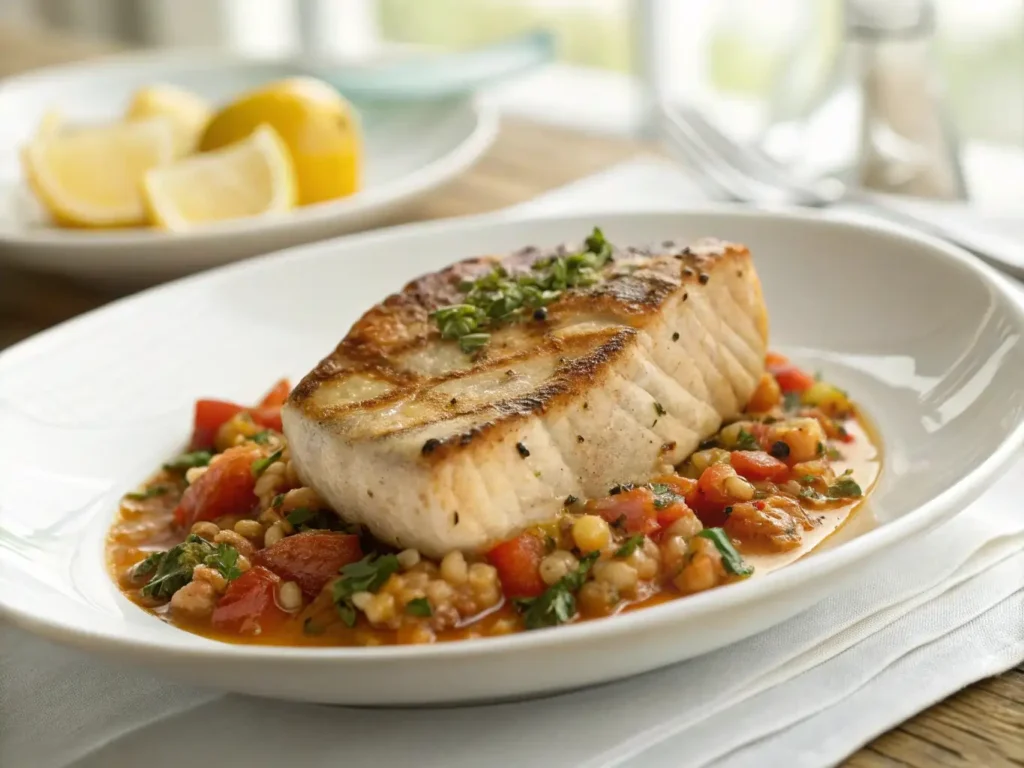
The beauty of swordfish lies in its versatility as a centerpiece protein that pairs harmoniously with countless flavor profiles. Mediterranean influences provide perhaps the most natural complement, with bright, acidic notes that balance the rich, meaty texture of the fish. A simple sauce of extra virgin olive oil, freshly squeezed lemon juice, minced garlic, and chopped fresh herbs (parsley, oregano, or basil) spooned over the hot steaks adds moisture while enhancing flavors without overwhelming the fish’s natural taste. For a more sophisticated finish, consider a quick pan sauce made by deglazing your cooking pan with white wine, then reducing with shallots, capers, and a touch of butter for silkiness.
Temperature serves as a critical yet often overlooked aspect of serving swordfish optimally. Unlike some seafood that can be enjoyed chilled, swordfish shines when served hot or warm. Slightly warmed plates prevent premature cooling, while proper resting (3-5 minutes) ensures that juices redistribute throughout the fish before cutting. This brief rest period also provides the perfect window to prepare serving plates and final garnishes.
The visual presentation of swordfish deserves thoughtful attention. The distinctive steaks, with their clean white color and defined texture, create an impressive centerpiece for plating. For restaurant-quality presentation, consider these professional techniques: position the swordfish slightly off-center on the plate, allowing space for accompaniments; slice thicker steaks on a slight bias before plating to showcase the perfect doneness; and create height by leaning the fish against a small mound of side dishes or by using a bed of complementary ingredients like sautéed spinach or roasted vegetables.
Complementary side dishes should balance swordfish’s robust nature while creating a nutritionally complete meal. Grain-based options like lemon-herb quinoa, farro with roasted vegetables, or Mediterranean orzo salad provide complex carbohydrates and additional textures. For lighter accompaniments, consider a crisp fennel and orange salad, blistered cherry tomatoes with fresh basil, or roasted asparagus with lemon zest. Starchier sides like garlic-herb roasted potatoes or creamy polenta work beautifully for heartier appetites. The key lies in balancing flavors and textures—something crisp or acidic helps cut through the richness of the fish.
Beverage pairings can elevate your swordfish dinner to new heights. White wines typically complement swordfish best, with medium-bodied options like unoaked Chardonnay, Vermentino, or Greco di Tufo offering sufficient structure without overwhelming the fish. For preparations featuring tomatoes or Mediterranean herbs, consider a light-bodied red like Pinot Noir or a chilled Beaujolais. Beyond wine, sparkling water infused with citrus slices provides a refreshing non-alcoholic option, while craft lagers or wheat beers work surprisingly well for casual dining occasions.
Garnishing represents the final artistic touch that completes your presentation. Consider these professional garnishing elements: microgreens or small herb sprigs for color and aroma; edible flowers like nasturtiums or pansies for special occasions; citrus supremes (peeled segments) for bright color contrast; or a light dusting of high-quality finishing salt like fleur de sel or smoked sea salt applied just before serving. These elements should enhance both visual appeal and flavor without becoming distractions.
Leftovers present unique opportunities for creating entirely new dishes with minimal effort. Cold leftover swordfish transforms beautifully into Mediterranean-inspired fish salads when flaked and combined with white beans, arugula, and lemon vinaigrette. For hot preparations, gently reheat chopped swordfish with fresh herbs and fold into risotto or pasta during the final minutes of cooking to prevent overcooking. Alternatively, create luxurious fish tacos by briefly warming the fish with southwestern spices and serving with fresh slaw and avocado in warm tortillas. When reheating, remember that gentle, brief warming preserves moisture better than aggressive reheating methods.
Seasonal considerations should influence your serving decisions. During summer months, lighter accompaniments like grilled vegetables, chilled grain salads, and herb-forward preparations complement the season’s bounty. In cooler months, heartier pairings like roasted root vegetables, creamy purees, or warm bean dishes create satisfying comfort. This seasonal approach not only provides variety throughout the year but typically results in more economical and environmentally conscious dining by utilizing peak-season ingredients.
Nutritional balance in your overall meal deserves consideration when planning accompaniments. The lean protein of swordfish pairs beautifully with complex carbohydrates and fiber-rich vegetables to create a nutritionally complete plate. Consider the “Mediterranean diet plate” approach: one-quarter protein (your swordfish), one-quarter whole grains or starchy vegetables, and one-half non-starchy vegetables or salad. This balanced approach supports both satisfaction and nutrition while allowing the swordfish to remain the meal’s focal point.
For special occasions, consider serving tactics that elevate the dining experience. Family-style service—placing a large platter of sliced swordfish steaks alongside several complementary sides at the table’s center—creates an interactive, communal dining experience. Alternatively, individual plating with careful attention to composition and garnish creates a restaurant-quality presentation that honors both your culinary efforts and your guests.
Conclusion
Mastering the art of preparing perfect swordfish steaks represents a culinary achievement worth celebrating. Throughout this guide, we’ve explored the journey from selecting quality swordfish to presenting it as the centerpiece of an impressive, nutritious meal. The techniques, tips, and insights shared here provide you with everything needed to transform this magnificent fish into consistently exceptional dishes that balance flavor, nutrition, and visual appeal.

